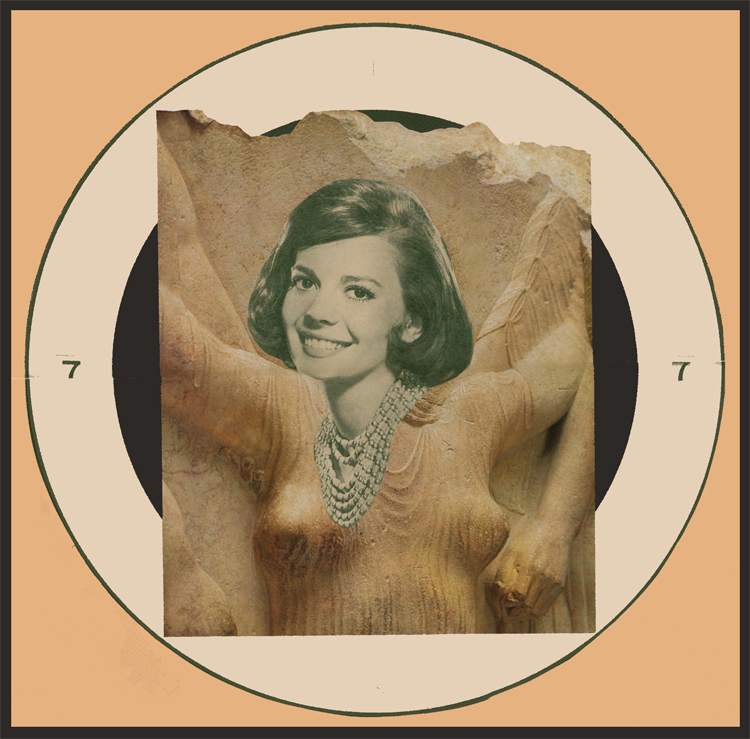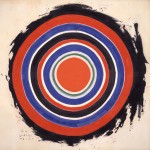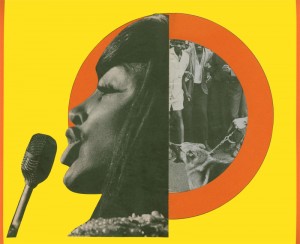By Bob Hicks

William Tell and Robin Hood were fair hands at them. In war, they can be crucial to battle strategies. But in the art world, it was Kenneth Noland who took targets off the practice range and put ’em on the map.
“Yes, I love him. I love him. I’ve always loved him,” Portland artist Eva Lake says of Noland, whose famous target paintings made him an icon of mid-twentieth century New York art. “And I love Josef Albers. I love something inside of something inside of something.”
 Lake has a new exhibit of collages on view at Augen Gallery‘s DeSoto space, and while they draw obviously on Noland, they’re also very much their own thing: not so concerned with Noland’s color-field theories, much more concerned with social meanings.
Lake has a new exhibit of collages on view at Augen Gallery‘s DeSoto space, and while they draw obviously on Noland, they’re also very much their own thing: not so concerned with Noland’s color-field theories, much more concerned with social meanings.
“I am the one doing this,” she says. “I am the one putting the woman in the target.”
Lots of women, and most of them famous: Lake is fascinated with the allure and effects of celebrity culture, particularly strong and beautiful women who have been vilified or victimized or pushed to extremes in one way or another. Natalie Wood. Tina Turner. Marilyn Monroe. Lana Turner. Carole Lombard. Liz Taylor. Jean Shrimpton. Naomi Campbell. Ann-Margret. Lindsay Lohan. Liza Minnelli. (“It’s not that I relate to Liza; I relate to Sally Bowles.”)
Lake, who is also a journalist (she interviews artists on her lively program Art Focus on KBOO community radio) has long been a force for feminism on the Portland art scene, at one point even keeping a running tab on the number of male versus female artists whose shows were reviewed in the local press to point out what she considered a sharp imbalance.
 Unlike a lot of people, Lake looks on these celebrity sex goddesses as powerful women who used their brains and their looks to gain position in a culture that didn’t offer them a lot of other avenues to success: “To be a beauty is a very dangerous thing, right?”
Unlike a lot of people, Lake looks on these celebrity sex goddesses as powerful women who used their brains and their looks to gain position in a culture that didn’t offer them a lot of other avenues to success: “To be a beauty is a very dangerous thing, right?”
She’s been fascinated by the Photoplay culture since childhood, and a lot of the images she uses in her collages come from such fan magazines. When she talks about her collage work a torrent of insider celebrity information engulfs you and threatens to sweep you out to sea.
Unlike a lot of collages that have an intricate mosaic feel, Lake’s targets tend to be simpler, pared down to a couple or three juxtapositions: the target itself, of course; the woman in the target; a physical context, usually nabbed from an art book. She pairs Liz Taylor with a Delacroix, Ann-Margret with a John Chamberlain, Marilyn Monroe with a Goya.
“So I’m obviously dealing with art history,” she says. “I like putting women in art history, because you don’t find them there very often unless they were naked or something.”
Lake studied painting at the Art Students League of New York, and she’s probably better known as a painter than a collagist — she’s done some good, Op art-influenced oils made of wavy lines that play around with repetition and color — but collage is an old friend. “I actually think I own that more than I own painting,” she says. “I was doing collage back in the punk days.”
Targets apparently are an old fascination, too. Lake talks about growing up in the southern Oregon town of Ashland — a hybrid of working-class, college and Shakespeare festival cultures — and sneaking onto the police department’s target range to steal targets. Obviously the image means something to her.
So does her own unusual path into the art world, which includes time as a makeup artist in California and earning a daytime Emmy award for it, then moving on to work with Chanel and Ferragamo. She still does professional makeup, and is both proud of it and a little touchy about the subject, because it places her outside the general art-school scheme of things. “I’ve had to defend that,” she says. “All the time. That I like beautiful things. That I make beautiful things. That I wear beautiful things. Quite honestly, it’s very difficult to make a beautiful object. And people put it down.”
Time was, of course, when beauty and art were just assumed to go together. Lake is highly opinionated, and she’s unwilling to let go of that link. On the other hand, on her KBOO radio show she easily interviews all sorts of artists who have all sorts of ideas. “Art is a conversation,” she says “It’s really easy, though, when you’re an artist, not to have a conversation. So the radio … guarantees that I will have to go out and see this stuff.”
Meanwhile, can her targets take the shots? Certainly they set themselves up for a charge that they’re too easy, simplistic, didactic. I don’t think the charge sticks. The pieces have clarity, and there’s plenty of room inside these images to think about what the juxtapositions imply. The goddess, the whore, the victim, the manipulator, the idolized and idolatrous, the creator and the sellout. Sure, these women are squarely inside the target — and for the most part they considered the advantages and disadvantages and chose to be there. You can look at these collages in a lot of ways, and I think Lake likes that.
*
ILLUSTRATIONS, from top:
— “Target No. 49 (Natalie),” collage, Eva Lake, 2010
— “Beginning,” magna on canvas painting by Kenneth Noland, Hirshhorn Museum and Sculpture Garden, 1958/Wikimedia Commons
— “Target No. 25 (Tina),” collage, Eva Lake, 2010